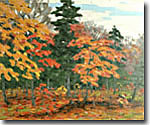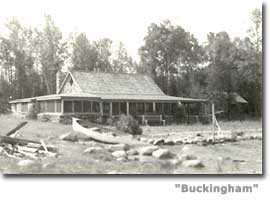 George Thomson was John and Margaret Thomson’s first born. He spent nine years on his grandparents’ farm in Claremont as five more children joined the family. George’s grandparents, Tam and Elizabeth Brodie Thomson, lived in the stone house across the lane from his parents’ stone house. The extended Brodie/Thomson clan participated in music evenings and exemplified a love of reading and learning. George Thomson was John and Margaret Thomson’s first born. He spent nine years on his grandparents’ farm in Claremont as five more children joined the family. George’s grandparents, Tam and Elizabeth Brodie Thomson, lived in the stone house across the lane from his parents’ stone house. The extended Brodie/Thomson clan participated in music evenings and exemplified a love of reading and learning.
In 1877 after Tam and Elizabeth had died, and when baby Tom Thomson was old enough to travel, John and Margaret set out for a new life in Leith where four more children were born. Margaret’s sister Henrietta and their niece Lottie joined the burgeoning Thomson family on the farm called Rose Hill.
Family life revolved around farming, learning, music and religion. Rose Hill backed on to Colonel Telford’s farm and as a result, the Colonel and John Thomson became good fishing buddies. Thomson and Telford families also mingled at church where George sang in the choir.
As the first born, George had many responsibilities. According to Dorothy Telford, grand-niece by marriage to George, “Every fall he went with his father in a large row boat to the point to catch fish for the winter. They would come back with the boat filled with fish and his mother would put the fish in barrels with salt. They would have enough fish for the winter.”
Although George helped out until after his high school graduation, there was scant work in Owen Sound and he did not wish to become a farmer. The lure of the new railroad to the west beckoned him. At 21 he set out to make his fortune. He arrived in Seattle by way of Chatham. While in Chatham he had taken business courses, including some from Frank McLaren of Seattle.
In 1892/3 George and Frank McLaren brought together the Seattle and Puget Sound Business College and the Acme Business School. Although they named the new business the Consolidated College Company, by 1903 it was known as the Acme Business School. George was instructor and partner in this new business and at various points his brothers Ralph, Henry and Tom studied there.
Shortly after creating their business partnership, George married Frank’s sister Margaret Euphemia. A son, George McLaren Thomson was born. Sadly Margaret Euphemia languished after the birth and died within six months. George settled in to raise his son with the help of the McLaren family.
After a decade, George was not satisfied in Seattle as a business college instructor. The law degree from the University of Washington in 1901 did not satisfy him either. In 1906 the vision of a finely painted landscape in a store window changed his life. According to a 1964 Frank Barkey article in The Owen Sound Sun-Times, “George saw displayed in a shop window a fine, modern colorful picture – a seascape of the California coast, with rocks, cliffs and rolling sea, This picture fascinated him and woke in him the instinct and determination to paint.”
After 13 years as a business college owner/instructor, George sold out and moved to New York to study at the Art Students League. He was 38 years old. Within a year he had art works accepted at the National Academy of Design in New York and the Art Institute of Chicago. He supported himself with part time jobs as a book keeper and cashier.
George next moved to New Haven to study under the artists of the Lyme Colony. The New Haven Union newspaper of July, 1908 states, “Mr. Thomson’s work is characterized by a fidelity to truth as revealed in nature and shows at first glance strength and simplicity of design and refinement of color.”
During the New Haven years George exhibited extensively in the United States so much so that he was considered an American artist. L.R. Hammond reports in the Saturday Chronicle of Nov 8, 1913, “George Thomson of New Haven is a painter whose canvases are done in accordance with what’s accepted as the best thought in American landscape painting.”
Although far from his family, George corresponded and made many visits to Owen Sound. He made sure that his son George McLaren joined him from Seattle when he visited his parents who had by 1903 moved to 4th Avenue in Owen Sound. While on holiday he also frequently met with the lovely Jean Telford, daughter of his family’s former Leith neighbour.
In 1916 at 48 years of age George married Jean Telford. Jean moved to New Haven. The newlyweds were in Canada in July 1917 when the telegraph arrived to say that Tom Thomson’s canoe had been found empty on Canoe Lake. George was dispatched to Algonquin Park to assist with the search. As the eldest child and a lawyer, George was designated to handle the furor and confusion that followed upon the discovery of Tom’s body.
After the turmoil subsided somewhat, George and Jean returned to spend a fruitful decade in New Haven. George continued to blossom as an artist and Jean made a home for him. However, when his mother died in 1925 George determined to return home. He had suffered from stomach ailments for years and he wanted to give up his daytime business-related jobs so that he could concentrate full time on his art. He also wanted to support his father. George was very close to his father and still handled most of his affairs.
The February 1926 marriage of his father to his aunt Henrietta altered George and Jean’s plans somewhat. Instead of moving into the spacious 4th Avenue home, George and Jean settled into the Telford home on 8th Avenue. The 8th Avenue house was capacious with a view of Georgian Bay, but, it was also quite full. In 1926 Colonel Telford, his wife, maiden daughter Kate and son Jim resided there. However, George and Jean soon moved in with their piano which they had brought from New Haven. George loved to play piano at Christmas.
George sketched out of doors and completed works in the dining room which had the best north window. He placed works in the attic to dry. At the end of each morning’s painting session, the very orderly George cleaned his palette and moved all his supplies into a small room behind the dining room. Dorothy Telford relates that when there were no planned parties, and George loved company, paintings were left against the wall where she and others eagerly viewed them. “Uncle George was very different from most artists I knew. He was very regimented and I always thought that was because of his business school experience.”
As well as annual spring and fall painting expeditions into Muskoka with his siblings Margaret and Fraser, spouses and sometimes Margaret’s friends, George had other accommodating drivers. Frequently his brother-in-law Jim drove and the Telford sisters catered when he went on sketching expeditions.
Artist John Corfe, who had painted with Group of Seven members, also drove the pair to sketch. “I can’t imagine two more unlikely painting partners,” said Dorothy. “George was very religious, a teetotaler and didn’t smoke. John drank, smoked and was very flamboyant.” The painting partnership, however, worked.
Artist Horace Vick also drove George out for sketching expeditions. Mr Vick related to Dorothy Telford that when he visited 8th Avenue, “he noticed a bushel basket in the back shed. This basket was filled with Tom Thomson paintings. It set there until the first book came out about Tom when George then moved the basket to the attic.” George did have two lovely sunsets painted by Tom in his living and dining room.
In the 38 years that George Thomson painted in the environs of Owen Sound, Muskoka and Haliburton, he produced a prodigious and much loved body of work. His annual works were shown in Toronto and Owen Sound and came to hang not only in great galleries but in a multitude of homes and public buildings. He was generous with his art talks and with assistance to local artists. By 1963 he had justifiably been named Owen Sound’s Citizen of the Year. Throughout the years, reviews of his works were glowing.
Augustus Bridle wrote in The Toronto Star, Feb 7, 1942, “Thomson always was a scientific painter. With his high sense of rugged beauty in the Georgian Bay milieu, he has for 20 years painted the country that he knows as intimately as Homer Watson knew Doon and the Grand River, into thousands of beauty-spots on canvas.” After this 1942 review, George painted another 23 years!
George outlived all the residents of 8th Avenue. The day before he died, he was out sketching with his brother Fraser at Lion’s Head and Barrow Bay. He was 97 years old—at the time, the oldest practicing professional artist in Canada. |
![]()
![]()




 George Thomson was John and Margaret Thomson’s first born. He spent nine years on his grandparents’ farm in Claremont as five more children joined the family. George’s grandparents, Tam and Elizabeth Brodie Thomson, lived in the stone house across the lane from his parents’ stone house. The extended Brodie/Thomson clan participated in music evenings and exemplified a love of reading and learning.
George Thomson was John and Margaret Thomson’s first born. He spent nine years on his grandparents’ farm in Claremont as five more children joined the family. George’s grandparents, Tam and Elizabeth Brodie Thomson, lived in the stone house across the lane from his parents’ stone house. The extended Brodie/Thomson clan participated in music evenings and exemplified a love of reading and learning.